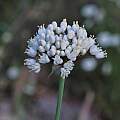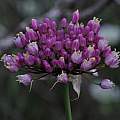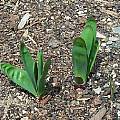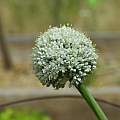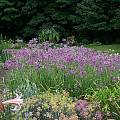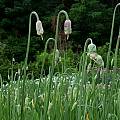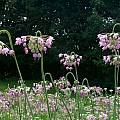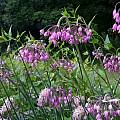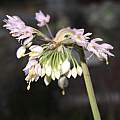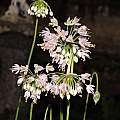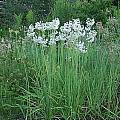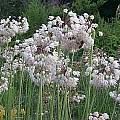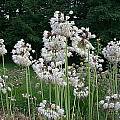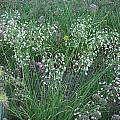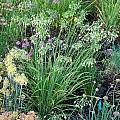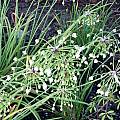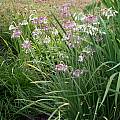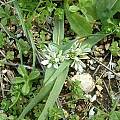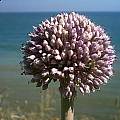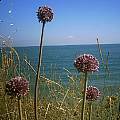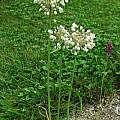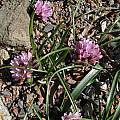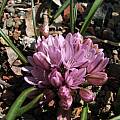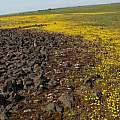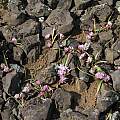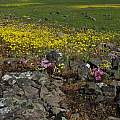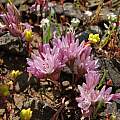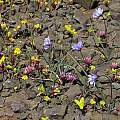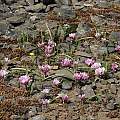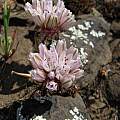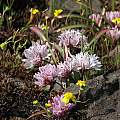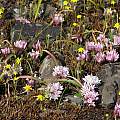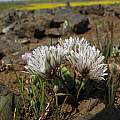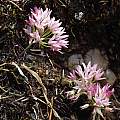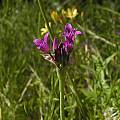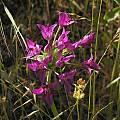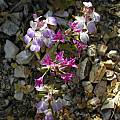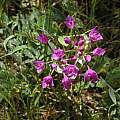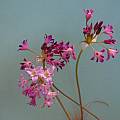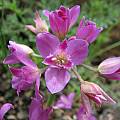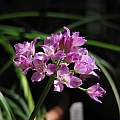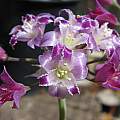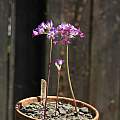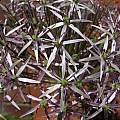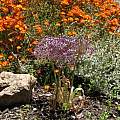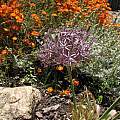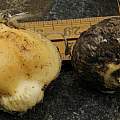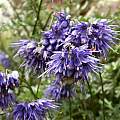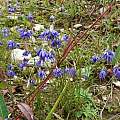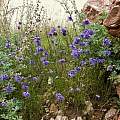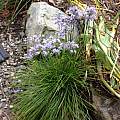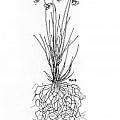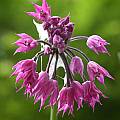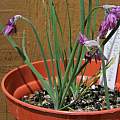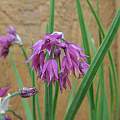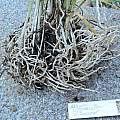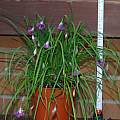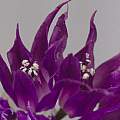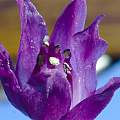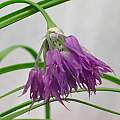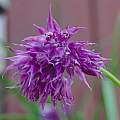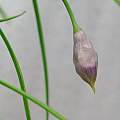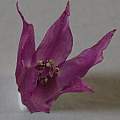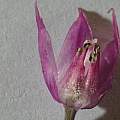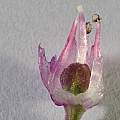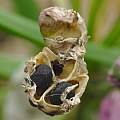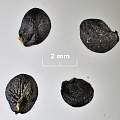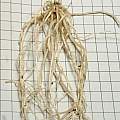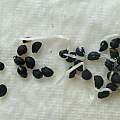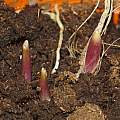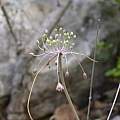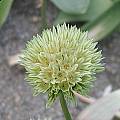This page compiles all the information and photos of the Allium taxa, cultivars, and hybrids we currently have on the PBS wiki. The Allium index gives information about the genus and includes tables of species and hybrids and cultivars.
Page 1: A. Globemaster... Page 2: A. atropurpureum... Page 4: A. decipiens... Page 5: A. guttatum... Page 6: A. karataviense... Page 7: A. membranaceum... Page 8: A. paradoxum... Page 9: A. regelii... Page 10: A. serra... Page 11: A. tardiflorum... Page 12: A. vineale...
Allium carmeli is a species native to Israel, Syria and the Lebanon. The white form is typical for Mount Carmel, while in other populations consist of the pink form. Photos by Gideon Pisanty.
Allium carolinianum is not from Carolina at all, but a Himalayan species. It can be a difficult plant to please, and in most years the buds abort for some reason. The foliage is quite remarkable, being very thick and waxy, particularly when first emerging. The first photo is early in the spring; the second was taken June 2002, when at least one of the buds was spared and condescended to flower. The plant is variable. I have grown better performing forms in the past, but alas over the years the others have perished. Photos by Mark McDonough.
Allium cepa is the cultivated onion. Typically grown as a biennial, it is a perennial plant normally planted in the Autumn for harvest the following Spring or Summer without being allowed to flower. They aren't the best garden plants as the large hollow stems are easily bent and will not tolerate much in the way of wind or disturbance. The dense flower heads, normally between 2" to 3" across, are attractive to bees who collect the nectar and occasionally the pollen. Allium cepa var. aggregatum, also known as the shallot, is seen in the photo below by Travis Owen.
Allium cernuum Roth, the nodding onion, hails from most states within the USA (and up to Canada) and therefore is extremely variable. The first 4 photos of a massed planting from Mark McDonough. In the first view, we see prolific blooms on a tall rose purple form of the "nodding onion" flowering in late June. In the lower left corner of the photo is Lilium formosanum var. pricei. In the second we see 4 nodding buds. It is clear why the "nodding onion" received such a common name, when one views the drooping buds. In this view the buds are just breaking through the bud spathe. The third is a similar view to the preceding, but here the flowers are open, showing nice pink rotund florets, hanging downwards. The final shot is a "good pink form" - the tall stems growing up through the invasive Campanula takesimana. The last two photos from Travis Owen are of a seed grown Allium cernuum, flowering for the first time in July of 2015.
Allium cernuum 'Leo' - one of my favorite cultivars, with tall, stiff stems to 30" (75 cm) or more, topped with clusters of white flowers (sometimes showing a tinge of pink in cool weather) that are denser than normal. Also distinctive in it's late flowering, in full bloom in mid August. The foliage is also shorter and neater than most cernuum forms... could have some A. stellatum blood in it. In the last two close-up views of the flowers the very short and tight "crook-necked" buds, the later than normal flowering period, along with the sideways disposition of the inflorescence, indicates some A. stellatum influence. Photos by Mark McDonough.
Allium cernuum 'Oxy White' (syn. A. oxyphilum) - I've tried photographing this delicate beauty for years but never really captured the essence of this fine plant. From southeastern USA, once regarded as a separate species (A. oxyphilum), most authorities now regard this as merely a form of A. cernuum , as do I. It's a most airy and delicate plant, with slender stems, and thread-thin pedicels holding little white flower droplets. In the last photo, seedlings of A. cernuum 'Oxy White' show lots of variation and a tendency back towards normal cernuum appearance. Photos by Mark McDonough.
Allium chamaemoly is a winter flowering species found in numerous Mediterranean areas including North Africa. Photo by Angelo Porcelli.
Allium commutatum Guss. - A very late flowering allium for a Mediterranean plant, in bloom from July or later. This curious species grows on rocky slopes by the ocean and at the time of flowering is totally leafless. Bulbs are salt resistant and floaters, and they are dispersed during sea storms. Plants are found also growing deeply embedded in the pebbles of the beaches, haven fallen down from the slopes above. Photo in habitat by Angelo Porcelli
Allium convallarioides Grossh. is a European species that's not generally in cultivation. It is a pleasing species with handsome umbels of white flowers. It is similar in appearance to Allium paniculatum L. and Allium pallens L., but in this species the slightly "ballooned" hollow leaves distinguish it from the other species. It flowers in June and July. Photos by Mark McDonough.
Allium cratericola Eastw. is a lovely little onion restricted to California. It is most often observed in the wild in Table Mountain in Butte County. The inflorescence stays appressed to the ground. In California, it tends to bloom much earlier than other onions, often times forming seeds by the middle of April. It can tolerate a variety of substrates including serpentine, volcanic, and granitic sediments. The key to cultivation is that the medium must be well drained with some organic matter. It likes being in full sun. Winter water is necessary, but a dry summer dormancy is extremely important. Photos by Nhu Nguyen. Photo 1-2 were taken at the Tilden Botanic Garden.
The photos below were taken on Table Mountain in Butte County. They show various color forms and this species growing with other geophytic friends.
Allium crenulatum Wiegand or Olympic Onion is a species native to Oregon and Washington states and British Columbia. The species is variable in its Oregon range and tend to be more uniform in the more northern range. Plants flower from late May to July on talus slopes and clay soils, including serpentine. Photos by Kathleen Sayce taken on Saddle Mountain in NW Oregon.
Allium crispum Greene is a species that grows in the coast ranges of California south of San Francisco in clay and serpentine soils. This is a long blooming Allium. The photos below were taken in situ by Mary Sue Ittner April 2005 in an especially wet year. Photo 1 shows a flower in bud in Pinnacles National Park and photos 2-3 are of flowers blooming along a bank on Jolon Road in Monterey County. Photo 3 shows it with a light colored Collinsia heterophylla Buist ex Graham. Photo 4 taken at Figueroa Mountain.
The photos below are of cultivated plants. Photo 1 was taken by Mary Sue Ittner in 2004 showing flowering plants she is growing. Photos 2-5 were taken by Nhu Nguyen. Photo 2 shows the crinkled edges of the petals, thus giving this species its specific ephithet, crispum.
Allium cristophii Trautv. (often misspelled as christophii) is a species with blue-purple flowers. It is native to central Turkey (Kayseri), northern Iran, and Turkmenistan. It widely cultivated. In cultivation, I put the plants into a dry summer dormancy after flowers/seeds have developed. When winter comes around, even if water is available, the bulbs will only make roots and will not emerge until spring. Flower photos by Nhu Nguyen. Photo 1 shows details of the flowers. Photos 2-3 show the inflorescence(s) grown in the ground in front of a dazzling display of the iceplant Drosanthemum bicolor L.Bolus. Bulb photo by David Pilling.
Allium cyaneum Regel is a dwarf, mid to late summer flowering blue allium from China. It is extremely variable, but typically a small plant 6" or less in height, with fine grassy foliage, and small pendant to semi-erect sprays of starry blue flowers, variable in color from pale grayish blue to deep cobalt blue. Albino forms are known but rare. The first three photos from iNaturalist were taken by Leoš Smutný in China in July and shared under a CC BY-NC license. The fourth photograph was taken by Rimmer de Vries who comments: "this is typically offered as an impostor for Allium beesianum, but has super fine grass-like foliage, is shorter, blooms later and the stamens extend beyond the tepals". The last image is a drawing by Mark McDonough.
Allium cyathophorum Bureau & Franchet is a Chinese species that reportedly grows in meadows and slopes in rock crevices at elevations of 2700–4600 m. Two varieties are widely accepted: var. cyathophorum and var. farreri.
Allium cyathophorum var. cyathophorum has petals that are rounded at the apex compared with the acute or pointed petals in var. farreri, there is also a small difference in the shape of the filaments. Grows at a higher elevation, typically around 3000-4600 m.
Allium cyathophorum var. farreri (Stearn) Stearn (syn. Allium farreri Stearn) is native to China where it grows on grassy slopes at high elevations of around 2700-3600 m. It has reddish purple flowers with stamens fused in a tube. It appreciates moist conditions in summer and tolerates shade. It flowers late spring to summer. First photo by John Lonsdale. Following two photos of first year flowers by RH grown in pots in the UK, initially obtained as Allium sibthorpianum Schult.&Schult,f. from Alpine Garden Society seed. Last photo by Travis Owen shows the root mass. The roots are present year-round and should not be allowed to dry out.
Photos by David Pilling taken at the start of June 2013; this plant was grown from seed supplied as Alium sibthorpianum and sown at the start of 2009; it has been flowering for a couple of years.
Disassembling the flowers: these photographs were taken a few days later than the ones above and it is apparent the flowers are now more red. Photo 4 shows a ripe seed pod with seed visible. Photo 6 is of the roots after the plant had gone dormant at the end of the year. Flora of China says of the type species "Roots rather long, thick. Bulb solitary or clustered, cylindric; tunic grayish brown, fibrous, sometimes subreticulate." and provides an illustration.
Seeds were put in a zip-seal bag with damp kitchen towel on 14th December 2013 and exposed to outside temperatures (around 40 °F); by the middle of January 2014 they had begun to germinate as shown in photo 1. Photo 2 is of the shoots of mature plants.
Allium daninianum Brullo, Pavone & Salmeri is a species from Israel, Syria, Lebanon, Palestine and Jordan. Photo by Gideon Pisanty.
Allium darwasicum Regel is another Central Asian species. This one intrigues me with its creamy white and green-striped flowers, but I like it mostly for the incredibly sweet candy-like scent. Photo by Mark McDonough.
Page 1: A. Globemaster... Page 2: A. atropurpureum... Page 4: A. decipiens... Page 5: A. guttatum... Page 6: A. karataviense... Page 7: A. membranaceum... Page 8: A. paradoxum... Page 9: A. regelii... Page 10: A. serra... Page 11: A. tardiflorum... Page 12: A. vineale...
Allium index - Allium flavum Relatives - American alliums A-F - American alliums G-Z - Big Ball alliums - Blue alliums - Chives - Domed alliums - Drumstick alliums - Rhizomatous alliums
